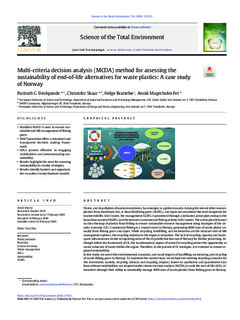Multi-criteria decision analysis (MCDA) method for assessing the sustainability of end-of-life alternatives for waste plastics: A case study of Norway
| dc.contributor.author | Deshpande, Paritosh | |
| dc.contributor.author | Skaar, Christofer | |
| dc.contributor.author | Brattebø, Helge | |
| dc.contributor.author | Fet, Annik Magerholm | |
| dc.date.accessioned | 2020-03-17T14:18:48Z | |
| dc.date.available | 2020-03-17T14:18:48Z | |
| dc.date.created | 2020-03-04T14:42:40Z | |
| dc.date.issued | 2020 | |
| dc.identifier.issn | 0048-9697 | |
| dc.identifier.uri | http://hdl.handle.net/11250/2647231 | |
| dc.description.abstract | Plastic, and its pollution of marineecosystems, has emerged as a global concern. Among the several other sources,plastics from a bandoned,lost,or discardedfishing gears(ALDFG), and ropes are considered the most dangerous for marine wildlife. In EU states, the management ALDFG is prioritized through a dedicated action plan owing to the hazardous nature of ALDFG and the increase in commercial fishing activity in EU waters.The action plan demands to close the loop of plastics from fishing to ensure sustainable resource management using strategies of the cir-cular economy (CE). Commercial fishing is a crucial sector in Norway, generating 4000 tons of waste plastic annually from fishing gears and ropes. While recycling, landfilling, and incineration are the standard end-of-lifemanagement options, the recycling industry in the region is immature. The lack of recycling capacity and in adequate infrastructure results in exporting most of the recyclable fraction out of Norway for further processing. Although within the framework of CE, the transboundary export of waste for recycling misses the opportunity to create value out of waste within the region. Therefore, in the pursuit of CE strategies, it is essential to ensure regional sustainability. In this study, we assess the environmental, economic, and social impacts of land filling, incinerating, and recycling of waste fishing gears in Norway. To represent the current state, we include two existing recycling scenarios for the assessment, namely, recycling (inland) and recycling (export). Based on qualitative and quantitative data from relevant stakeholders, we adapted multi-criteria decision analysis (MCDA) to rank the end-of-life (EOL) alternatives through their ability to sustainably manage 4000 tons of waste plastics from fishing gears in Norway. | nb_NO |
| dc.language.iso | eng | nb_NO |
| dc.publisher | Elsevier | nb_NO |
| dc.rights | Navngivelse 4.0 Internasjonal | * |
| dc.rights.uri | http://creativecommons.org/licenses/by/4.0/deed.no | * |
| dc.subject | Avfallshåndtering | nb_NO |
| dc.subject | Solid waste management | nb_NO |
| dc.subject | Livsløpsanalyse | nb_NO |
| dc.subject | Life Cycle Assessment | nb_NO |
| dc.subject | Industriell økologi | nb_NO |
| dc.subject | Industrial Ecology | nb_NO |
| dc.title | Multi-criteria decision analysis (MCDA) method for assessing the sustainability of end-of-life alternatives for waste plastics: A case study of Norway | nb_NO |
| dc.type | Journal article | nb_NO |
| dc.type | Peer reviewed | nb_NO |
| dc.description.version | publishedVersion | nb_NO |
| dc.subject.nsi | VDP::Teknologi: 500 | nb_NO |
| dc.subject.nsi | VDP::Technology: 500 | nb_NO |
| dc.source.volume | 719 | nb_NO |
| dc.source.journal | Science of the Total Environment | nb_NO |
| dc.source.issue | C | nb_NO |
| dc.identifier.doi | 10.1016/j.scitotenv.2020.137353 | |
| dc.identifier.cristin | 1799613 | |
| dc.description.localcode | 0048-9697/© 2020 The Author(s). Published by Elsevier B.V. This is an open access article under the CC BY license (http://creativecommons.org/licenses/by/4.0/) | nb_NO |
| cristin.unitcode | 194,60,25,0 | |
| cristin.unitcode | 194,64,25,0 | |
| cristin.unitcode | 194,20,21,0 | |
| cristin.unitname | Institutt for industriell økonomi og teknologiledelse | |
| cristin.unitname | Institutt for energi- og prosessteknikk | |
| cristin.unitname | Viserektor Ålesund | |
| cristin.ispublished | true | |
| cristin.fulltext | original | |
| cristin.qualitycode | 2 |

